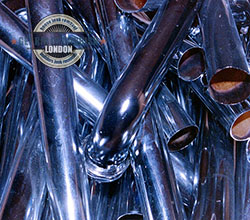Just like most other metals, steel and aluminium have value even as scrap (metal waste) as they are quite versatile in terms of post-recycling uses, and deriving their new counterparts from ore is expensive and energy intensive. There is a huge variety of products and items made of recycled steel and aluminium, actually recycling of these two metals is perhaps one of the first forms of metal recycling out there.
Steel or tin cans are amongst the most versatile recycling inputs. The derived recycled steel is widely used in the manufacturing of push and motor bike parts, car parts, toy model cars, steel beams and girders used in construction, rebar also used widely in construction, household appliances like washing machines, ovens etc. and of course new tin cans.
 It is interesting to note that tin cans are in fact steel cans coated in a thin layer of tin which is corrosion resistant (steel isn’t unless galvanised or otherwise treated). During recycling steel is separated from tin, most new steel contains a certain amount of recycled steel.
It is interesting to note that tin cans are in fact steel cans coated in a thin layer of tin which is corrosion resistant (steel isn’t unless galvanised or otherwise treated). During recycling steel is separated from tin, most new steel contains a certain amount of recycled steel.
The majority of aluminium cans from soft drinks, beer and other beverages are used for the manufacturing of new aluminium cans for the same purpose. Of course, recycled aluminium is used for a variety of other recycled products, such as and airplane body panels etc. What makes aluminium so good for recycling is that the metal retains its quality and properties after whatever recycling technology it was subjected to thus giving the same high quality recyclate as the input material. This also allows for aluminium waste be recycled indefinitely, making it a sustainable solution in a way. At the moment, the high demand for aluminium cans worldwide has pushed manufacturers to develop highly efficient recycling technologies which allow for a new can to hit the supermarket shelves all across the world within sixty days of it being recycled. Producing new cans from recycled ones saves about ninety five percent of the energy needed to produce the same number of cans through ore (bauxite) extraction.
Glass is also another relatively versatile recyclable which is used in the manufacturing of many different products for the household and industry. However, different types of glass require different recycling methods and some of them have specific uses as recycled materials. Generally, glass is separated into three types clear (jars, milk bottles etc.), brown glass – beer bottles, and green glass – again beer bottles and others too. Glass waste is first separated by colour using optical, computerised equipment and then broken down to small pieces which are eventually melted for further processing. Apart from the conventional use of recycled glass for new glass jars, bottles, containers etc. recycled glass is also widely used for production of fibreglass – necessary for construction and engineering of structures and vehicles.
All of this underscores the importance of effective waste management practices beginning at grass root level i.e. educating people of the importance of recycling, then efficient rubbish removal practices, quick and effective separation methods etc.
